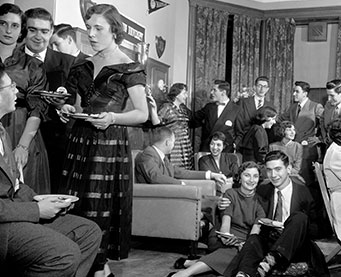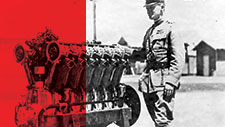Then Now Next
How a decidedly pro-male movement at BU led to progressive reform—and created the institution we know as the School of Management.
Men, Men, Men. That’s what the relatively small number of male Boston University alumni wanted to see more of at their alma mater. It was the early twentieth century, and graduates of the previous century were galled to learn that some were calling BU a “girls’ college.” Indeed, the Class of 1910 numbered nine times more women than men.
A group of these concerned alumni formed the “More Men Movement” at BU and commissioned a survey of local high school boys to learn what sort of postsecondary education they wanted. The collective response: practical courses that would train them for careers in business.
Next, the alumni asked local business leaders what those boys would need to be prepared for the commercial fields. (At a time before women as a group had made major strides toward equality, the business world was still largely closed to female aspirants.) The executives’ answer: courses in accounting, finance, and business principles, as well as the cultural grounding of a traditional college education.
Was it possible to give students both? It certainly wasn’t the norm in 1910. But the More Men alumni proposed a solution, one that would put BU on the crest of a sea change in American higher education.
A Demand Exceeding Supply
The generation of silver-haired men then at the helm of American business had seen and been part of a revolution in transportation, communication, and production. Plenty of these industry leaders had succeeded without the benefit of a formal education. They were self-made men who had started in apprenticeships on the bottom rungs of the business ladder. Others had gone to college, but, particularly in stodgy old Boston, that meant they had received a classical education on the seventeenth-century European model, befitting men of their station, and then entered the family business—where they began apprenticing, the way their self-made peers had started four years previous. Once in their jobs, these newly minted scholars found their experience translating Pliny had little immediate relevance to importing sugar.
That somewhat loosey-goosey system of producing a merchant class had been perfectly adequate in Colonial times and on through the 1830s. But, as Alfred D. Chandler, Jr., recounts in his classic text The Visible Hand: The Managerial Revolution in American Business, it made less and less sense as the nineteenth century progressed. Temporarily stalled by the Civil War and an economic depression, the dual march westward of railroads and telegraph lines resumed in the 1870s, eventually resulting in a truly national economy, with large multiunit corporations, cross-regional wholesalers, chain stores and mail-order houses, mass marketing, modernized factories, and major investment banking.
With this enormous network of intertwined commercial activities developing, too much was at stake to leave its continued success dependent on pluck and luck. The barons of industry who had overseen this growth now wanted to retire and confidently hand over the reins to a capable class of up-and-comers.
But who were those young Turks, and where would they come from? “The search for better, for more competent men, from the presidents of our great companies down to our household servants, was never more vigorous than it is now,” wrote efficiency expert Frederick W. Taylor in 1911. “And more than ever before is the demand for competent men in excess of the supply. What we are all looking for, however, is the ready made competent man; the man whom someone else has trained.”
Enter, Someone Else
Boston University and a few other pioneering institutions, such as Dartmouth College and the University of Pennsylvania, would take it upon themselves to do the training that everyone was hoping someone else would do.
It wasn’t an easy sell. When Everett W. Lord (CAS 1900, GRS’06, Hon.’60), leader of the More Men Movement, pitched a business program to BU’s trustees, the very concept of business education suffered from a bad reputation in academia, thanks to that era’s sketchy underworld of unaccredited correspondence schools. The faculty of BU’s College of Liberal Arts (CLA, now the College of Arts & Sciences) was almost uniformly opposed to Lord’s proposal. Current SMG Professor James Post has uncovered documents of the debate in which professors described the idea as “impractical . . . contrary to the principles of Boston University . . . undesirable . . . unacademic” and (paradoxically) “unbusinesslike.”

Everett W. Lord at his desk. Photos above and top courtesy of SMG archives
Lord, however, argued that situating a course of business study within BU’s humanities curriculum would serve not only students but society as well. His focus on the well-being of male students may seem narrow today, but for his time, Lord was a socially conscious progressive—which helps explain his interest in business education. (In Transformations: A History of Boston University, author Kathleen Kilgore also notes that Lord’s call for more men struck a markedly different tone from many other institutions facing dwindling numbers of male students. Based on “sex repulsion theory,” they tried “devising ways of excluding women”.)
After spending his youth as a cook at sea, Lord attended CLA, graduating in 1900. He worked as a teacher, then school administrator, in his native rural Maine before moving to Puerto Rico. There, he helped develop a public school system and became an advocate for fair treatment of the island’s people. In 1908, the National Child Labor Committee hired Lord as its New England secretary, and he helped curtail the abuses in Maine’s sardine industry, which had been employing 7-year-olds to work 12-hour shifts handling 18-inch knives (often resulting in gruesome accidents).
Lord was part of a national backlash against such Gilded Age excesses. Even rank-and-file businessmen soured on the laissez-faire era: the monopolies stifled competition, and the rampant speculation caused repeated depressions. Robber barons were bad for business.
For an incipient school of business education, that meant graduates should go into the world with both nitty-gritty business know-how and a big-picture understanding of how their industries fit into the economy and society at large.
“This college maintains the theory that in a capitalistic democracy our leaders and executives, and, indeed, all our voters, need an intelligent appreciation of capitalism in its relation to democracy and human welfare,” Lord would say years later. “We have refused to recognize a distinction between the cultural and the practical, but believe, rather, that every subject of study may be, and should be, at once cultural and practical.”
School in Session
The BU trustees and president approved of Lord’s business program on the conditions that he and his alumni group raise funds for it from outside sources, and that it be a night school separate from CLA (although it would use CLA classrooms in Copley Square, after hours). Massachusetts Governor Eugene N. Foss and Boston Mayor John F. “Honey Fitz” Fitzgerald (grandfather of future US President John F. Kennedy) bought the first bonds for the new College of Business Administration (CBA). Lord himself became the College’s first full-time dean.

A University gathering in the fifties. Photo courtesy of SMG archives
The first CBA classes were held in October 1913. The College enrolled 274 students—including 40 women—that year. About 30 of the students were college graduates (including alumni of Harvard, Yale, and Brown) looking to acquire new skills. The most popular courses were Elementary Accounting, Commercial Law, Commercial Composition and Business English, and Economics. With his experience in Puerto Rico, Lord made sure Spanish language classes were also offered, and he brought in various guest speakers from the business community to give students up-to-date accounts of the realities of management, sales, and advertising.

A campus shot from the sixties. Photo courtesy of SMG archives
The College’s rapid growth reflected the demand. In its second year, 425 students enrolled, and tuition revenues exceeded expenses; Honey Fitz and the rest of the bondholders were repaid. In its third year (1915/1916), 675 students enrolled, and the trustees were convinced the College was a viable entity deserving a bigger commitment of resources. They authorized expanding CBA into a full-time program, making it the first undergraduate college of business in New England.
Enrollment leapt to 1,438 students in 1916/1917. Cramped in the CLA space, CBA moved to its own headquarters at 525 Boylston Street (MIT’s old building), on Copley Square. The College’s first day class graduated in June 1917, just months after the US entered the First World War.
Roaring Along, Weathering a Crash
As 4.8 million Americans enlisted or were drafted into the war effort, a shortage of qualified managers placed new demands on the nation’s few business colleges. Enrollment only rose after the Armistice in November 1918, as veterans used their service bonus money for tuition, and the movement to professionalize business education gained momentum as the consumer economy boomed throughout the 1920s. CBA was doing so well, Dean Lord even experimented with an international campus, opening a branch in Havana, Cuba. (A steep drop in the price of sugar scotched the plan before it took flight.) He had more success with a CBA summer term in his old hometown of Ellsworth, Maine.
After the stock market crash in 1929, enrollment declined across BU. However, Lord commissioned more surveys, this time showing the value that employers placed on a college degree. CBA’s enrollment declined the least of any school or college at BU.
Lord would later point to the success of CBA graduates in finding employment even in 1932 and 1933, the nadir of the Depression. In 1938, he told the Christian Science Monitor that BU’s and other universities’ business colleges had had a “vitalizing effect” on higher education generally by creating competition with the liberal arts, to the benefit of students. Moreover, he said, some graduates of CBA and the other top business schools had raised the national standard of business education by taking teaching jobs at the smaller commercial colleges and in high schools’ commercial departments. Finally, academic research units, like BU’s Bureau of Business Research, had supplied chambers of commerce and other business organizations with some of their most dependable economic information.
In September 1939, a few weeks after Nazi Germany invaded Poland, CBA was the first BU school to move to the new Charles River Campus. Its new home was the five-story limestone Charles Hayden Memorial at 685 Commonwealth Avenue. Lord would retire in May 1941, seven months before Imperial Japan bombed Pearl Harbor.
Nominal and Actual Change
After the postwar G.I. Bill bubble, CBA’s enrollments declined in comparison with those of BU’s other schools. The College fell victim in part to the very competitive atmosphere it had helped create, in part to a manufacturing decline in New England, and in part to the departure of its advertising and news reporting courses for BU’s new School of Public Relations (now the College of Communication).
In 1971, new BU President John Silber (Hon.’95) hired consultant Peter Gabriel of McKinsey & Co. to study the University’s strategic future. Silber was so impressed with Gabriel that he hired him as the dean of CBA in 1973. Gabriel’s major initiative at CBA was to eliminate CBA, the name.
“We are a school of management and for management,” the dean wrote in a memo to the faculty. “As such, we are concerned with teaching, research, and problem-solving related to all kinds of organized activity and to all kinds of institutional settings, private and public, in which such activity takes place.”
In another memo, Gabriel outlined what he saw as the institution’s primary objective: “To become one of the country’s foremost centers of education, research, and innovation in the functions and techniques of management of private and public institutions.”
The trustees agreed with Gabriel that “College of Business Administration” no longer encapsulated what the school was and what it was going to be. In August 1974, CBA became the School of Management.

A glimpse of University life in the seventies. Photo courtesy of SMG archives
Over the course of that decade, the School added master’s degree programs—in manufacturing and business administration, including MBAs in health care management and public management—as well as a doctoral program in business administration. In the years since, SMG has adapted to advancing technology and a globalizing economy with a master’s program in information science, a program in management practices in Asia, invaluable research centers, and other initiatives.
Under long-serving Dean Louis Lataif (’61, Hon.’90), SMG moved in 1996 to its present home, the spacious and state-of-the-art Rafik B. Hariri Building at 595 Commonwealth Avenue. In his 19 years at the School, Lataif led it through more than just a physical overhaul. His innovations included a new emphasis on team learning and teaching, the introduction of a cross-functional curriculum, and the creation of nine endowed professorships.
The semantics have changed over the course of a century. Today you’re more likely to hear current dean, and former Quest Diagnostics CEO, Kenneth W. Freeman talk about how the School “creates value for the world,” rather than how it provides a “service to society,” as Lord did. But the meaning is the same, and so is the mission.
Moreover, the demographics have changed. Today’s SMG students come from around the globe, and the student body is 45 percent female, a far cry from . . . Wait a minute, less than half? Perhaps as the School’s next century begins, it’s time for a More Women Movement.
-

1913
In 1913, a Ford Motor Company plant installed the first assembly line for mass automobile production. In other developments that year, Western Union engineered a method of transmitting eight messages over a single telegraph wire, the temperance movement gained traction, the Revenue Act lowered tariffs on foreign goods and established the federal income tax, and the Federal Reserve System was created.
And on the evening of October 13, 1913, classes began at BU’s new College of Business Administration. “The study of the problems of business provides one of the best exercises in developing thinking ability,” said Everett W. Lord, CBA’s founder and first dean. By helping his graduates develop that ability, Lord sought to provide a service to society. Photo courtesy of SMG archives
-

1916
In 1916, CBA became a full-time program, with both day and evening classes—the first full-time school of business in New England. It also moved out of the cramped quarters it had shared with the College of Liberal Arts, and into its own building across Copley Square, recently vacated by MIT. The following spring, CBA’s first senior class graduated, just weeks after the US entered the First World War. A boom in wartime industrial production was followed in the 1920s by a boom in consumer goods purchased on credit. Photo courtesy of National Museum of the United States Air Force
-

1929
After the stock market crash of 1929, the nation entered a long depression, and university enrollments plummeted. CBA weathered the storm—its enrollments declining the least of any BU unit. In 1939, the College became BU’s first to occupy space on the Charles River Campus, moving into the brand-new Charles Hayden Memorial Building at 685 Commonwealth Avenue.
Also that year, Germany invaded Poland. The US military then was ranked 39th in the world. But after the Japanese bombed Pearl Harbor in 1941, bringing the Yanks into the Second World War, American industrial production skyrocketed. Ford and other auto plants churned out tanks, guns, and aircraft. By the end of the war, more than half of the world’s manufacturing was taking place in the US. Photo courtesy of SMG archives
-

1973
In 1973, the US agreed to a ceasefire with the North Vietnamese. Hopes were high that in the wake of President Richard Nixon’s 1972 visit to China, a vast market would open up for American goods. But the Arab oil crisis brought more bad news—high prices and long lines at the pump.
Peter Gabriel (the management consultant, not the singer) became dean of CBA. By the following year, 1974, he succeeded in renaming the institution the School of Management, to better reflect the range of its programs and its enhanced offerings to come during that decade, such as MBA programs in health care and public management. Photo courtesy of WikiCommons

